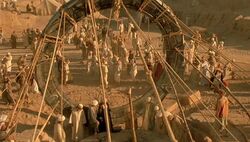If you ever wondered how to implement Save the Cat or if it’s worth the effort, seeing it in action will help you visualize its value. Let’s put this plotting technique to the test. Does Stargate, a ’90s Sci-Fi action movie, fit into the beats?
Join me in this discussion on what made Stargate a success, and why even now, twenty-six years later, it is still a joy to watch.
What is that enigmatic Save the Cat and how do you use it?
The creator of Save the Cat beat sheet, Blake Snyder, claimed that after analyzing dozens of popular movies, he discovered what they all had in common and wrote it down as fifteen story beats. Whether you’re writing a screenplay or outlining a novel, Save the Cat Beat Sheet will help you hit the essential beats your story narrative needs to keep your audience invested.
At least, that’s the theory. But how do you put it into practice?
Staring at beat descriptions that might not fully apply to your story can be as riveting as IKEA instructions. Examples are your friend. When you analyze a structure of a movie you’re well familiar with, you will understand what the beats are and can get inspired for how to plot or improve your own story.
Let’s put Blake Snyder’s claim to the test by analyzing Stargate.
What is Stargate?
Stargate is a 1994 Sci-Fi action movie, starring Kurt Russel, James Spader, and Jaye Davidson, directed by Roland Emmerich.
Here’s my logline for it:
After journeying to an unknown planet, a nerdy Egyptologist and a grieving soldier must use their specialized skills to defeat a powerful alien before it comes to Earth.
Stargate is a great example for our exercise because it has elements that are often difficult to place into structured storytelling, namely – two main characters. And its success proves it a good example of storytelling done right (the movie gained a cult following and the concept was turned into a TV show that ran for ten seasons).
WARNING: There are spoilers below.
Stargate told with Save the Cat
Save the Cat was developed as a technique for writing movie scripts, but it works great as a plotting device for novels. Trying to stay close to the beats and their location within the story will help you maintain good pacing. But how do you recognize each beat?
Here’s a basic Save the Cat beat sheet:
Act 1 20%
- Opening image
- Set up
- Theme stated
- Catalyst
- Debate
Act Two 60%
- B Story (or more)
- The promise of the premise
- Midpoint
- Bad guys close in
- All is lost
- Dark night of the soul
Act Three 20%
- Finale
- Final image
I like to break the Finale into this structure and would love to test it out on this movie:
- Gather the team
- Storm the castle
- High-tower surprise
- Dig deep down
- Execution of the new plan
Let’s see how Stargate fits into the beat sheet.
Below breakdown summarizes the important scenes of the movie, and it nearly sums up the entire movie. Very few scenes did not have to be included. Lesson to learn from it: each scene should have a purpose.
You will notice some beats repeated. That’s normal. Certain beats normally do get repeated (Set up, Fun and games or Bad guys closing in are most often repeated), but also, this movie has two main characters. Each character has their own beat sheet, but below outline combines the two to form one story. You’ll know what I mean when you get into it.
Pay attention to the repetition of the theme element. I had watched this movie countless times but never noticed the purpose behind the symbols until I wrote all of this down Save the Cat style.
Notice how “exciting sci-fi moments” are sprinkled throughout the entire story. This is a lesson on how to not forget your main genre. You have to deliver what you promised your audience. What does this movie promise in the trailer and the description: a journey across the universe, action, mystery of the pyramids and the ancient Egypt, and hostile aliens with advanced tech.

ACT 1.
Opening image: 1920s Egypt – they dig up the artifact.
Theme: the golden medallion.
Set up
Intro to main character 1, Jackson. He’s giving a lecture. No one believes him when he suggests that there’s something fishy about the pyramids. His life sucks.
Inciting incident for Jackson – Strange old lady offers him a job.
Debate for Jackson – Do I take the job? The moment of decision is very symbolic. Comfy, dry limousine with her (and the offer) or pouring rain outside.
Intro to main character 2, Colonel O’Neil. Hints of a backstory. They show him sad, wife doesn’t care anymore (dismissive words, smoking). He’s holding a handgun and looking at pictures of a little boy. Did his son die by the handgun? Or is he contemplating suicide? They never say. This is a good setup for him – he’s got nothing left to lose.
Inciting incident for Colonel – he’s called to duty.
Set up continued – we learn that the old lady is the little girl from the opening image. Colonel shows up. Military supervision = conflicts and rising tensions. Jackson is salivating over the ancient symbols on the artifact.
Catalyst
Jackson figures out the symbols. Stargate is activated. A very exciting sci-fi moment.
Debate for Colonel
They don’t know if they’ll be able to come back once they cross over. They’re about to abandon the idea of a reconnaissance mission, but Jackson wants to go (implied by the way he’s eyeballing the gate). He tells them he can figure it out and bring the team back. This introduces the stakes – they rely on his ability to open the gate from the other side or the whole team will get stuck there.
Theme – The old woman gives the medallion to Jackson.

BREAK INTO ACT 2
They go through the gate. A very exciting sci-fi moment.
Promise of the Premise:
Welcome to the new world = a worldbuilding heaven.
First pinch point – it’s not that easy to solve the puzzle and open the gate. The soldiers are angry with Jackson.
B story and tension:
Meanwhile Colonel is doing something without his team’s knowledge. Very quick scene. No answers.
Plot point – Jackson follows footsteps and finds a strange animal. He gets caught in the harness and the animal brings him all the way to meet the locals. Another exciting worldbuilding moment: a human civilization.
Side characters introduced – the teen boy and the elderly leader.
Theme – the locals notice the Ra symbol on the medallion and kneel down. This is when the medalion starts to represent the freedom theme.
Debate for Colonel – the locals are inviting them. Should they go? He’s distrustful, but a sandstorm is coming. They take shelter with the locals.
Character development – Colonel is still grumpy. No change in him yet.
Fun and games
Partying with the locals. Comedy gold.
Side characters introduced – the pretty girl offered to Jackson and the dummy friend of the teen boy.
Notice that up to here the characters just went with the flow – as circumstances changed, they did not change their usual ways but made decisions as they always have. Lessons had not been learned yet.
By this time all of the setup should have been completed. Tension should start amping up now.
Midpoint
Plot point: The arrival of the alien. Exciting sci-fi stuff.
Character development. Colonel makes friends with the teen boy. There’s a soft side to him. When the boy reaches for his gun, he freaks out.
Fun and games – The girl is showing Jackson their forbidden drawings. Touching moment for Jackson but also a worldbuilding continuation.
Bad guys closing in: Soldiers that stayed at the pyramid are in trouble. One of them witnesses the alien come out of the fancy steamcoffin.
Character development: Sweet moment with Colonel and the local teens.
Plot point: Jackson learns the story of the alien and why the stargate was created. We learn the backstory of the locals and the alien these people think of as god Ra.
All is lost
They find the symbols they need to activate the stargate but one symbol is eroded. They can’t go home.
Dark night of the soul
Soldiers go back to their camp and leave the locals behind. Very quick, sad moment.

BREAK INTO ACT 3:
Back in the pyramid.
Bad guys closing in – Our heroes find that the pyramid doesn’t look the same. Sci-Fi action scene with the enemy.
B story continued – Colonel goes to his secret case. Whatever he’s looking for is not there.
Plot point – They’re taken upstairs to meet the alien. Big sci-fi moment. Jackson learns about the bomb. What were you thinking, Colonel?
Character development for Colonel – A guilt-trip look from the slave children. He’s dropped into the watery prison and finds that his soldiers are not dead. But they’re trapped. Where’s Jackson?
Bad guys closing in and sci-fi moments – Airships attack the village. A moment with a child almost getting blown up (such a cliche). The elder is lamenting, we shouldn’t have helped them (implied).
More tensions – Meanwhile Jackson wakes up in the steamcoffin, completely healed. Time alone with the alien. A long conversation in a made-up language. Showing the bomb, Jackson’s face falling when he learns the evil plan. We can guess only guess how terrible it is.
Theme – the alien takes the medallion.
FINALE:
1. Gather the team.
Plot point – The girl gives a motivational speech to the teens while at the cave with the drawings – symbol of Jackson and freedom. Locals attend the alien’s ceremony. Jackson is instructed to kill the soldiers. The kids show him a signal that they have guns. He shoots at the alien instead (and misses, such a typical Jackson).
Action – big fight. Victory, the heroes get away, but they still don’t know how to get back home or defeat the alien.
Character development for Colonel – He takes the guns from the kids. No change in him yet.
Low point – what are we going to do? Jackson tells the soldiers about the bomb and his conversation with the alien. The alien is going to send the bomb back to Earth. Soldiers are disappointed with Colonel. Blame game with the Colonel (a bit unfair, he’s following orders).
Reminder of the tensions – Back at the pyramid the alien talks to his troops.
Still low point – Colonel is feeling low. He’s ready to die (implied) but he wanted to send his team home (implied). Jackson guilt-trips him into helping them organize a plan. Colonel doesn’t look hopeful.
Tensions – Back at the pyramid, the alien is being scary. Sci-Fi stuff.
Calm before the storm – The teens bond with Jackson. He bonds with the girl. First kiss.
Plot point and a breakthrough – The teen boy draws the missing symbol on the wall. They can go home.
Theme of freedom – Jackson shows the elder that the alien soldiers are human = a breakthrough moment for the elder.
Tensions – The alien is wearing a fancy cape. He’s playing with the bomb.
2. Storming the castle.
Plot point – The locals carry a delivery to the pyramid – a freaking trojan horse. It’s time for the big fight.
3. High Tower surprise.
Action, tensions and failures – The support troops are trapped outside of the pyramid. The heroes inside are on their own. Outside, the troops are fighting airships with machine guns. The alien is not happy, throwing food off the table.
Tensions with a timer – Colonel activates the bomb. You have 7 minutes to figure out the gate, Jackson (it wasn’t explained why he chose this moment to activate the bomb – a plot hole?). The girl protects Jackson and gets killed. He spots the elevator and hitches a ride with her body. Colonel fights the enemy soldier alone. Bad odds for him. Jackson brings the girl to the steamcoffin.
All is lost – Outside, the kids are fighting and getting killed. Big sad moment. There’s only a helmet left of the dummy boy. They’re all out of ammo. The alien looks smug. Colonel wants to stop the bomb but the guy he’s fighting is stronger.
Freedom theme – the local teens and the soldiers surrender and get on their knees.
Jackson revived his girl and is trying to get away but the alien spots him. He’s going to die by means of a brain-fry (sci-fi stuff).
4. Dig deep down
Finally something goes right – Colonel won his fight by using the spaceship tech against the alien soldier and accidentally saved Jackson and his girl.
Theme – Jackson takes the medallion back. The alien is angry.
Plot twist – Colonel is trying to stop the bomb but the timer will not stop. Oops. You’re all gonna die.
Outside, the teens are about to be punished for the attempted attack (freedom theme).
5. Execution of the new plan
Time for some wins – ALL of the locals come out from the top of the hill and spill down to help our heroes defeat the alien troops. Big victory for freedom.
The alien looks out at the celebration and has had enough. He’s going to get away in his spaceship. Jackson and Colonel send him a present – the bomb with only 6 seconds remaining. Big bada boom. Victory celebration.
Character development for Colonel – The teen and his friends salute. Colonel salutes back.
Happy ending – Jackson and the girl kiss.
Final image
Colonel and the soldiers are going back to Earth, leaving Jackson behind.
Theme – Jackson gives him the medallion.
Character development for Colonel – Will you be alright? Yeah, I think I will. His soul is healed. Lesson learned: It’s okay to trust kids with guns (lol).
Exciting sci-fi last image.
Analysis
– I didn’t time it, so I don’t know how well the above breakdown fits into the recommended % per act. In my impression, Act 3 took a large % but it was also the most exciting part of the movie – the part that gave us most delivery of the promised premise. I don’t know if what I’ve identified as the midpoint was in the middle of the story – it could have come before 50%, but I don’t think it was a problem.
– Scene function. Some moved the plot forward, some added tension, some were for character development, some were just for sci-fi fun, BUT most of the time, each scene had more than one function. Jokes were being said always during the Fun and Games/worldbuilding or action moments, not during tense moments, and there were TONS of tense moments.
– Pacing. Each scene was fairly short (under two minutes) – even the ones that established the worldbuilding. Total movie is 125 minutes, divided by two minutes, that’s 1.6% of total. There’s a lesson in this. If your book is 60,000 words, it would translate to 960 words per scene – that feels about right, doesn’t it? Longer, more complex books could have a different % allowance but I like how well this translates.
– A lot was being said without being said. It was implied with clues in the setting and body language of the characters.
– Balance – notice how between each plot point, you get a variety of different types of scenes. This is what made this movie exciting and well-paced.
– It’s also important to note how “sci-fi stuff” is a representation of satisfying the genre. It’s sprinkled throughout the story, not just all in one place, but I noticed the most of it in the time stamps of switching from one act to the next. The transition included worldbuilding.
– Symbols used:
- The medallion – the opening and final images, and in every important scene.
- Jackson’s sneezing (often at important moments for a comedic effect) – sometimes it’s used to contrast him against the soldiers.
- Writing and reading (forbidden to the locals) – symbol of freedom.
– Side characters were very memorable and so was the antagonist.
– Your character’s journey makes the story. I recognized character development for two characters:
- Colonel – from grief to acceptance. You could guess his backstory from the clues given. I’m really impressed by how well they did that part. His development wasn’t very deep but even a sci-fi action movie did not neglect that need.
- The elder, who represents the human population living on the alien planet – from an obedient slave to revolutionary.
This was a really cool exercise. There’s a reason why this was such a popular movie. There are a lot of cliche and poor elements in this movie that didn’t age well (only one female character, the only black character gets killed, etc.), but the movie is good because of how fast-paced it is and how much it delivers what it promised.
Stargate franchise is owned by Metro-Goldwyn-Mayer.
Discover more from Isobel Lynx
Subscribe to get the latest posts sent to your email.



